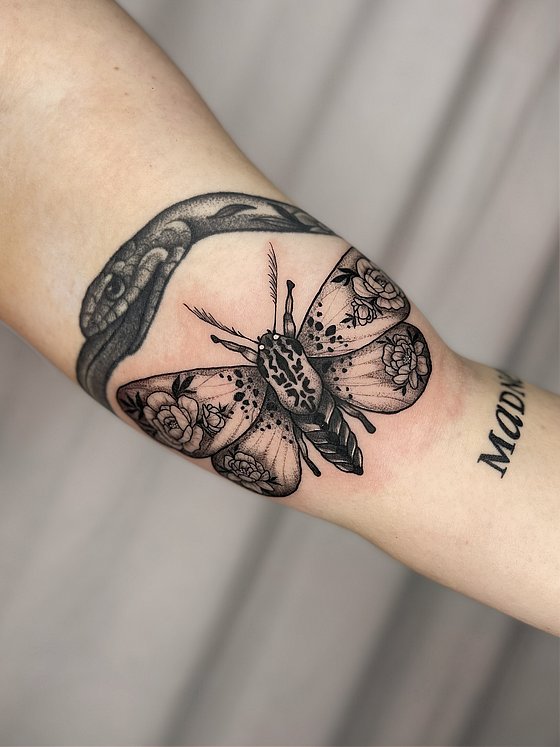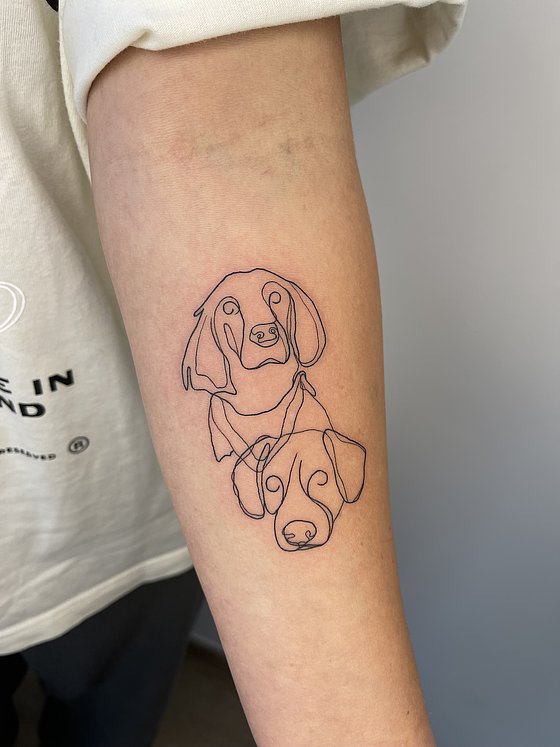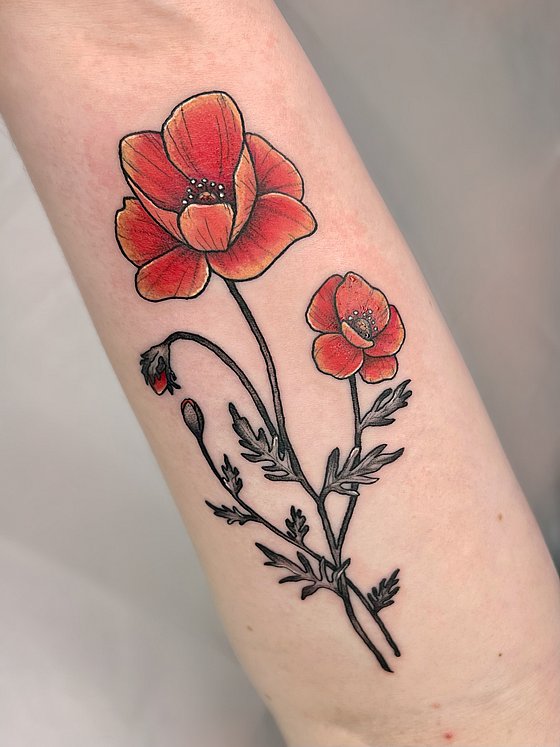
Tattoos - a touch of adventure
Prof Katja Pfeiffer / Art
Photo: Sebastian Jarych
Tattoos - A touch of adventure
Art professor Katja Pfeiffer on the history of tattoos
Mrs Pfeiffer, why do people get tattoos?
Pfeiffer: I'm not a recognised tattoo expert, and my main interest is in the intersection of tattooing and art.
The simple but unsatisfactory answer to the question of why people get tattoos is: "For as many different reasons as there are different tattoos." This can be deduced from observation alone if you look at the range of body parts affected and the varied range of motifs. There is certainly a trigger for every "tramp stamp", there are notorious occasions for tears at the edge of the eyes, and the immortalisation aspect of tattooed names and birth dates of partners and children may be easy to understand, even when viewed from the outside.
Of course, there are also surveys, national and international perspectives on tattooing as a phenomenon, differentiated by gender and researching motives. These studies ask questions from the perspective of those who are tattooed on the one hand, but also from the perspective of the observer on the other. Such studies trace the different motivations and also the consequences in the social environment. In Germany, around one in ten people have tattoos and around 5% of those surveyed are no longer very happy about it at some point. There can be many different reasons for this. For example, the feeling of only being able to turn up at work in long sleeves so as not to attract attention or not wanting to keep the name of a long-gone liaison of a new partnership constantly present.
During my research, I was surprised at how minutely everything imaginable was examined here, right down to consumer behaviour and preferences for experimental lifestyles and relationship models, which are allegedly somewhat higher among tattooed people than the average population. So tattoos still have an air of adventure about them, even if it's just two dolphins in the ankle area.

5200 year old mummy in the British Museum, on which a tattoo was found
Photo: public domain
Tattoos have a long tradition. The oldest Egyptian mummy of a man ever found is in the British museum. It is over 5000 years old and only now have two animal tattoos been found on it, from a time when hieroglyphic writing was not even fully developed. The depicted aurochs and the maned sheep were already known from the art of the time in connection with male virility. Is this visual body art from prehistoric times?
Pfeiffer : It would be speculation on my part to answer this question. I find the location of the exhibition interesting. The British Museum is full of artefacts whose provenance is disputed, as many of them were collected when Europeans embarked on their expansive voyages of discovery and had the crazy idea that they could simply take everything they found there with them. This overlaps with the legend that it was above all the contact between James Cook's ship's crew and the indigenous peoples they discovered that led to the spread of the first tattoos in Europe. As both the mummy in the British Museum and the well-known "Ötzi" with his tattoos from around 3250 BC prove, visual body art existed in Europe long before that. Presumably there were already various reasons, some of them certainly ritualistic, for wearing them. In the case of Ötzi, it has been suggested that the bundles of lines and cross-shaped marks were applied to the skin for therapeutic reasons and were intended to relieve pain. As early as the 19th century, the tattoos of indigenous peoples were the subject of research by many anthropologists and ethnologists. The findings on the differences in the understanding of the body are certainly interesting here. In the Christian tradition, the body was initially considered sacrosanct, its permanent painting was not permitted and led to "desecration". This changed, however, when pilgrimage sites and their tattoo parlours contributed to the spread and recognition of tattoos. There are now a number of exciting research papers that have compiled such findings in remarkable detail.
For a long time, tattoos were not considered socially acceptable; until the 18th century, their motifs were characterised by South Sea motifs by sailors, religious affiliations, signs of remembrance and identification or expressions of political ideologies. However, they then found their way into European literature, as the example of the full-body tattooed South Sea islander Queequeg in the novel Moby Dick shows, as well as into 19th century Japanese art, influenced by ukiyo-e art (Japanese woodblock prints). What influence did they have there?
Pfeiffer : The affiliation with seafaring is also confirmed by the first tattoo that I personally encountered on an object that is no longer alive. It was an anchor on an inlaid piece of skin in the anatomical museum of the Ospedale di San Giacomo in Rome. I was very fascinated and moved by this remnant of a biography.
As far as the South Sea islanders in canonised world literature are concerned, I also find it interesting to look at the other social effects of exoticism. People with full-body tattoos were popular "exhibits" at fairs in the first half of the 19th century. Other groups of people who differed visibly from the average population in some way were also turned into objects in this way and thus dehumanised.
The mechanisms with which we humans react to experiences of foreignness point to how challenging this task apparently is and how much it confronts us with our own identity or alterity. The constant change in the evaluation of tattoos is a good example of possible shifts in perception with regard to seemingly set evaluation standards. So far, however, it remains merely a hope that there is a kind of process of civilisation that ultimately leads to otherness being met with acceptance for the time being.

Tattoo example by Jana Fischer
With the liberation from the dingy corner of harbour bars, prisons and motorbike gangs, tattoos have lost everything disreputable and have now gone from being a fashion trend to a technically highly developed art form. Literary tattoos can also be found on Lady Gaga's upper arm. The pop diva has an excerpt from Rainer Maria Rilke's "Letters to a Young Poet" engraved there. What messages do tattoos convey today?
Pfeiffer : This question follows on from the first one, i.e. the question of "why". With their localisation in the skin, tattoos concern the boundary between the inner life and the outside world, they serve as a mediator between the private and the public. The skin can be "read" both as a cover or mask, but also in a figurative sense as a "synonym for the self", sometimes in the truest sense of the word.
In North and South America, the aim seems to be to make oneself more attractive to the respective sex of interest. According to surveys, European or German people particularly want to emphasise their individuality and uniqueness through tattoos.
If you look at the tattoos of outstanding studios, you can see works that are suitable for depicting or emphasising the uniqueness of the tattooed person's personality in both written and pictorial form. The process of finding an image is a long and individual one. According to studies, the varied content of the messages depends very much on the age of those who have their skin tattooed. If this happens during the transition to adulthood, the tattoo often marks precisely this threshold and has something to do with finding one's identity. Tattoos can also indicate notable transitional phases later in life.

Tattoo example by Jana Fischer
The English word tattoo comes from the Tahitian term "te tatau" and means "right, artful". In recent years, tattooing has become socially established, tattoo studios are booming and the motifs and themes have also changed. We are already familiar with art on the body through full-body painting. How important is tattoo art today?
Pfeiffer : When thinking about this, I find it important to ask whose tattoo art you are thinking about. A visit to an outdoor swimming pool may tempt you to ask this question in general. I myself became more involved with the phenomenon of tattooing when a tattoo machine appeared in our art class and the art students tattooed each other or themselves. Of course, not everyone did this and it wasn't part of the practical seminars, but I was completely fascinated. On the one hand, because the quality of the drawings in a school of art and design is naturally quite high, but on the other hand also because they were usually not huge full-surface images, but small emblem-like sketches. The messages are not necessarily clear to outsiders. Why would you tattoo a tetra pack? A single tooth? In many cases, I don't know either. What is interesting about this phenomenon, however, is that drawing on one's own body is one of the most direct forms of graphic appropriation and, moreover, it is usually not just a picture. The body becomes a sketchbook and forever carries with it the memory of our faculty and art studies at the University of Wuppertal. Of course, I thought that was very nice, but I hope that the majority of the memories will be nice ones and that not too many will have to reach for the laser afterwards. In any case, we took the wave of these body images as an opportunity to design a whole series of invitation cards with them.

Tattoo example by Jana Fischer
The tattoo artist becomes a "tattoo artist", the suburban shop becomes a "studio", the images in the skin become fashionable and a collector's passion. Today, individuals from a wide range of social and cultural backgrounds and of all ages are getting tattoos for a variety of reasons. What influence does this type of art have on the development of our society?
Pfeiffer: I don't know if I would go so far as to attribute a socially transformative power to tattoos. However, there are works of art that involve the tattoo medium that I would attribute a far-reaching effect to. Some artists, like the students, have had tattoos and other interventions on their own bodies. But there are also works that depict drawings on foreign bodies. One very drastic example is the work "8-Foot Line Tattooed on Sic Remunerated People" from 1999, in which the Spanish artist Santiago Sierra offered volunteers in Havana a payment of 30 US dollars if they had a horizontal line tattooed on their backs. Of course, it was not about the result as an aesthetic phenomenon. Rather, the work questions socio-political roles. It is about the act of a person making their own body available in return for payment, even if it is for a permanent mark on the skin. If you think about this further, you end up asking questions about the entire value structure of a society, because straight lines on the back are by no means the worst thing that some paid labour leaves behind on bodies.
Another artist, Wim Delvoye, has also gone very far in his work by making domestic pigs the bearers of his tattoos. He decorated the (stuffed) piglet body of "Louise" with the well-known handbag ornament of Louis Vuitton bags, for example. The questions raised here about the brand fetish also go far beyond the usual body paintings.
Would you get a tattoo?
Pfeiffer : Actually, I always think about what kind of tattoo I would get. Not at all to get it done, but to think about the durability of motifs. I find the idea of the finality of such a decision exciting. Unless you decide to go on and on. But even then, at some point your own available skin surface is occupied and there is no second page. I then think about what would mean so much to me at this point in time that I would want to look at it for the rest of my life. So far, I haven't come across anything that has lived up to this standard. I just want to look at too many different pictures.
My husband said he might get a tattoo saying that he doesn't like marzipan and is allergic to redfish... so that he doesn't get it shoved in his mouth by some geriatric carer later on when he can no longer say it himself. I laughed a lot about that.
Uwe Blass
Katja Pfeiffer, born in 1973, studied art and education at the Düsseldorf Art Academy under Günther Uecker, Alfonso Hüppi and Jan Dibbets as well as history at Heinrich Heine University. She was a master student of Alfonso Hüppi. She has been a professor of art specialising in artistic practice at the university of Wuppertal since 2006.
